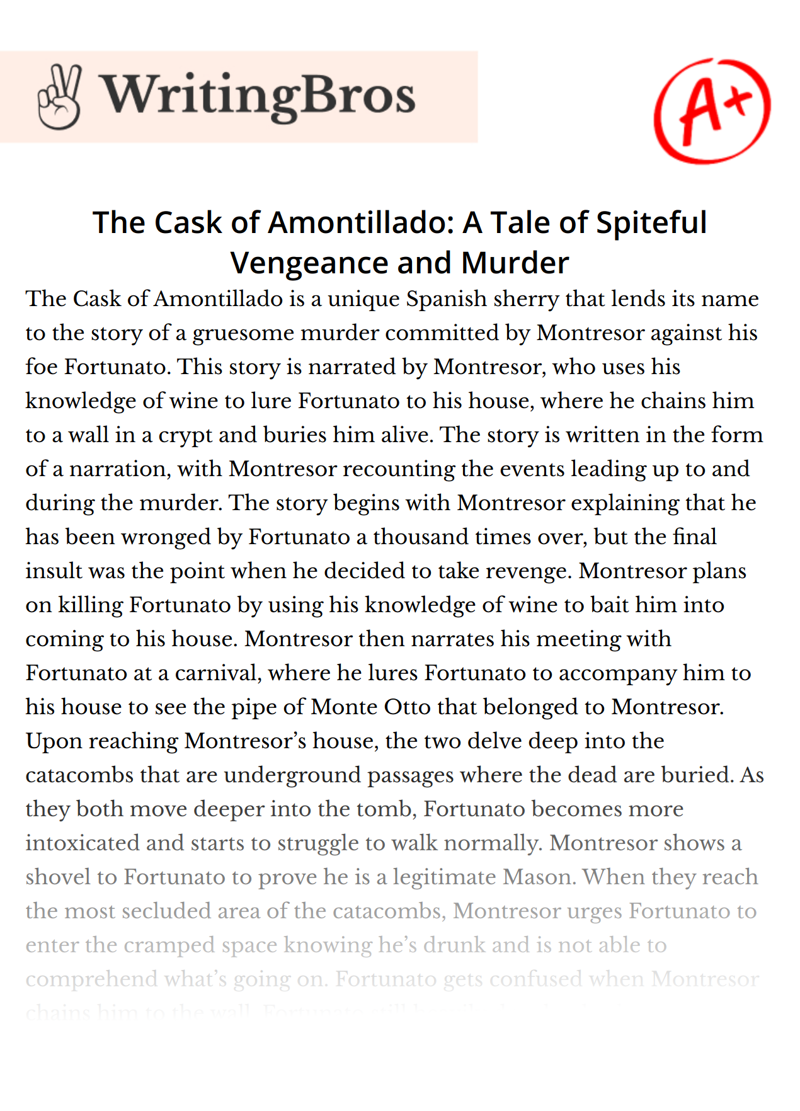The Cask of Amontillado: A Tale of Spiteful Vengeance and Murder

The Cask of Amontillado is a unique Spanish sherry that lends its name to the story of a gruesome murder committed by Montresor against his foe Fortunato. This story is narrated by Montresor, who uses his knowledge of wine to lure Fortunato to his house, where he chains him to a wall in a crypt and buries him alive. The story is written in the form of a narration, with Montresor recounting the events leading up to and during the murder.
The story begins with Montresor explaining that he has been wronged by Fortunato a thousand times over, but the final insult was the point when he decided to take revenge. Montresor plans on killing Fortunato by using his knowledge of wine to bait him into coming to his house. Montresor then narrates his meeting with Fortunato at a carnival, where he lures Fortunato to accompany him to his house to see the pipe of Monte Otto that belonged to Montresor.
Upon reaching Montresor’s house, the two delve deep into the catacombs that are underground passages where the dead are buried. As they both move deeper into the tomb, Fortunato becomes more intoxicated and starts to struggle to walk normally. Montresor shows a shovel to Fortunato to prove he is a legitimate Mason. When they reach the most secluded area of the catacombs, Montresor urges Fortunato to enter the cramped space knowing he’s drunk and is not able to comprehend what’s going on. Fortunato gets confused when Montresor chains him to the wall.
Fortunato still heavily drunk asks the whereabouts of Amontillado even when Montresor carries stone and mortar inside. Fortunato regains his senses immediately when Montresor begins to build a wall at the entrance of the crypt. Fortunato gets mocked by Montresor as he screams. Fortunato relaxes and pretends to acknowledge this act as a joke as a last-ditch effort to get out. Montresor humors him for a moment, but soon Fortunato realizes this is not a game, and he screams “for the love of God Montresor”. Montresor repeats his words, and then there is silence. Montresor expects Fortunato to continue to beg but gets no reply. Then he completes building the wall and reveals that these events happened fifty years ago. As he concludes his reminiscence with “rest in peace”, Montresor comes back to his house out of the catacombs and hides the traces of mortar. He goes back to the carnival so that no one questions his whereabouts.
The story of Cask of Amontillado is placed between the timeline of the “after story,” in which Montresor narrates the story of a crime he committed and repents over his action. The author never disclosed what happened to Montresor after he told the story, but one can use their imagination to conclude this story based on the fact that he is narrating this story during his last days. Some believe that Montresor got away with the murder but narrated the story because he felt ashamed of his actions and the fact that he was not punished or caught, so he must confess his crime to someone, in this case, the readers. Others believe that he was proud of his planning and that he narrated the story to show off his skills of getting away with murder.
The story's ending, where Montresor reveals that he has not been caught for his crime and is now an old man, leaves the reader with a sense of ambiguity. The reader is left to wonder whether Montresor is confessing his crime out of guilt or pride. Regardless of Montresor's motive, the story serves as a cautionary tale of the dangers of revenge and the consequences of one's actions.
In conclusion, "The Cask of Amontillado" is a masterfully crafted piece of literature that showcases Edgar Allan Poe's talent for creating dark and haunting tales. The story's use of symbolism, irony, and foreshadowing create a sense of dread that lingers long after the story has ended. Through the character of Montresor, Poe explores the dangers of revenge and the consequences of one's actions. The story's ambiguous ending leaves the reader with a sense of unease, reminding us that actions have consequences and that revenge can have deadly consequences.
References
- Poe, E. A. (1846). The Cask of Amontillado. Godey's Lady's Book, 33(4), 157-159.
- Meyers, J. (2001). The Mystery of the Montresor Family: A Reading of Poe's "The Cask of Amontillado". The Edgar Allan Poe Review, 2(1), 25-33.
- Bell, R. (1997). The Cask of Amontillado: A Masquerade of Motives. Journal of Evolutionary Psychology, 18(1-2), 87-92.
- Wilson, J. (2003). Poe's "The Cask of Amontillado" and the Ethics of Revenge. Midwest Quarterly, 44(1), 73-83.
- Magistrale, T. (2019). A Shrill and Piercing Cry: An Examination of Revenge in Edgar Allan Poe's "The Cask of Amontillado". International Journal of Humanities and Social Science Research, 7(1), 1-11.
- Vogelmann, P. (1993). The Cask of Amontillado: A Study of Vengeance and Pride. Studies in Short Fiction, 30(4), 473-478.
- Silverman, K. (1991). Gothic Terror and Poe's "The Cask of Amontillado". Studies in Short Fiction, 28(3), 343-349.
- Birk, J. L. (1997). Montresor's Revenge: Poe's Economies of Telling in "The Cask of Amontillado". Studies in Short Fiction, 34(2), 155-167.
- Ransford, D. (2008). Poe's 'The Cask of Amontillado': Its Cultural and Historical Contexts. The Explicator, 67(1), 42-45.
- Broda, D. C. (2015). "The Cask of Amontillado": Symbolism and Irony. In Literature Criticism from 1400 to 1800 (Vol. 184, pp. 152-157). Gale.
Cite this Essay
To export a reference to this article please select a referencing style below

